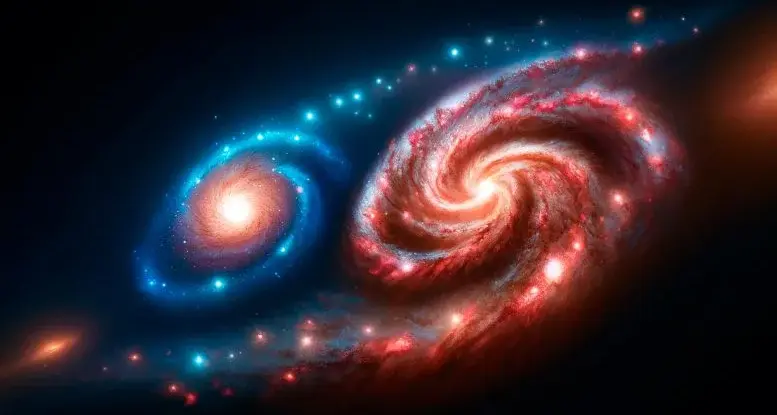Scientists see birth of oldest galaxies in universe for first time
- May 24, 2024
- 0
Using the James Webb Space Telescope, astronomers examined the spectra of three small galaxies from a time when only 400 to 600 million years had passed since the
Using the James Webb Space Telescope, astronomers examined the spectra of three small galaxies from a time when only 400 to 600 million years had passed since the

Using the James Webb Space Telescope, astronomers examined the spectra of three small galaxies from a time when only 400 to 600 million years had passed since the Big Bang. Researchers have managed to prove that distant young star clusters are closely surrounded by dense clouds of gas; The formation of the first galaxies of the universe continues.
According to the generally accepted model, galaxies consist of star clusters and primary neutral atomic hydrogen. Clusters attract gas that accumulates on the outskirts of galaxies, or halos. Over time, it cools and new stars begin to form in its densest regions. Therefore, it is important for us to see these gas clouds to study the formation of the first galaxies.
Usually astronomers look for such gas “star cradles” with a hydrogen radio line with a wavelength of about 21 centimeters. Unfortunately for the early universe this method does not work, there is not enough radiation power. But another spectral line of hydrogen fits this: the Lyman-alpha line. It’s just that scientists are mostly looking for absorption by gas clouds, not the radiation itself. At the same time, radiation comes from even more distant objects.
Astronomers from the University of Copenhagen (Denmark) selected three galaxies in the early universe based on the “quality” of the absorption of the Lyman-alpha line. The search was conducted using the open observation databases of the James Webb space telescope. Scientists managed to recruit a dozen candidates, from which three objects with the “cleanest” data were selected.
Three selected galaxies: CEERS-43833 as it existed 572 million years after the Big Bang (redshift (z) 8.76), MACS0647 — 467 million years after the Big Bang (z = 10.17), CEERS-16943 — 398 million years after the Big Bang. Explosion (z=11.4).
The problem was that absorption of the hydrogen line could cause normal distribution of gas in intergalactic space. There was also the possibility that each of these galaxies was located in a region of space where the gas density increased. To confirm this, the study’s authors conducted computer simulations.
It turns out that for such absorption rates the surrounding gas density must be 30-50 times higher than the average value; This is absolutely unrealistic. However, a cluster of gas was indeed found on the outskirts of the first galaxy, but it was only five times denser than “normal”; this was not sufficient to explain the observed data. The results of the study were published in the journal Science.
According to scientists, all three galaxies contain very young stars, younger than 100 million years. Their total stellar mass is 108-109 solar masses. At the same time, the mass of the gas “shells” surrounding them is two to seven times greater than the mass of the stars, and this is only an underestimate. Galaxies themselves may also contain interstellar gas that we cannot see. Then the total mass of these objects could be an order of magnitude higher.
“It can be said that these are the first “direct” photographs of the formation of galaxies. Previously “James Webb” showed us the subsequent stages of formation of galaxies, now we have seen their birth and thus the formation of the first star systems in the universe,” explained Kasper Elm Heints (Kasper Elm Heintz) from the Niels Bohr Institute, lead author of the paper.
A group of authors of a new study asked for more time for the work of “James Webb.” They want to obtain more precise observational data about selected galaxies. In addition, scientists hope to “peek” deeper into space, even closer to the Big Bang.
Source: Port Altele
As an experienced journalist and author, Mary has been reporting on the latest news and trends for over 5 years. With a passion for uncovering the stories behind the headlines, Mary has earned a reputation as a trusted voice in the world of journalism. Her writing style is insightful, engaging and thought-provoking, as she takes a deep dive into the most pressing issues of our time.